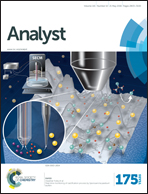A novel approach for precisely controlled multiple cell patterning in microfluidic chips by inkjet printing and the detection of drug metabolism and diffusion†
Abstract
In this work we report the use of inkjet printing as a precise and convenient means for microscale cell patterning in microfluidic chips followed by cell co-culture, stimulation and analysis. A self-made inkjet printing device was manufactured with adjustable parameters, which was capable of multiple cell printing within biocompatible materials. Sodium alginate was used as a printing matrix for cell encapsulation, and precisely distributed cell arrays on glass slides were obtained by accurate software controlled printing. By covering a PDMS layer with the corresponding microchannels onto the cell array substrate and subsequently injecting an ion cross-linking reagent, the cells containing alginate arrays gelated immediately and were immobilized on the bottom of the microchip, which could be utilized for cell culture and analysis. HepG2 cells and U251 cells were successfully co-patterned in the microchip and used for drug metabolism and diffusion experiment to imitate the in vivo situation, as a means to ascertain the capability of the system for precise microscale cell patterning in a microchip. The prodrug tegafur was metabolized by HepG2 cells into the active anticancer compound 5-fluorouracil and this produced an adverse gradient effect on U251 cells according to the distance from the HepG2 cells. The developed approach presented a feasible way to integrate inkjet cell printing and microfluidic chips for the first time, which is proved to be capable of spatially controlled printing of multiple kinds of cells into a microchip for cell culture, stimulation and analysis, which could be applied to tissue engineering, drug testing and related areas. We envision that the approach will help significantly increase the cell patterning efficacy in microfluidic chips as well as reduce the extent of laborious experimental work.



 Please wait while we load your content...
Please wait while we load your content...